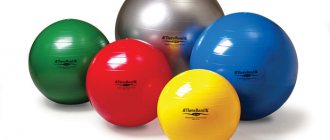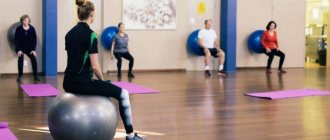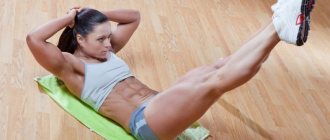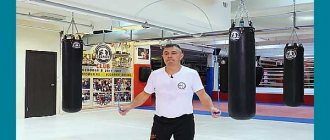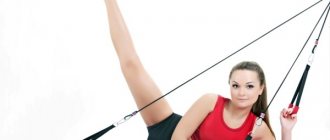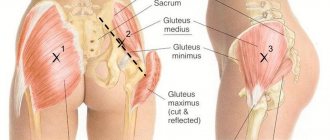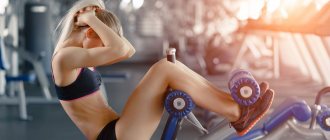Fitball: features and benefits
A large inflatable ball, called a fitball, is not always perceived as serious training equipment. And in vain: if used correctly, it will compete with an equipped gym.
V
Who invented fitball
“Swiss ball” is one of the names assigned to an elastic inflatable ball of large diameter, which is used for rehabilitation and training purposes. Despite this name, the fitball is of Italian origin: it appeared in the north of this country in the 50s of the last century in a small enterprise producing rubber toys. Perhaps this unusual ball would have remained in the category of gaming equipment if Swiss physiotherapists had not begun to use it in the rehabilitation of patients with cerebral palsy.
Americans, impressed by the results of using fitball for medical purposes when visiting European clinics, brought this knowledge to their homeland. The large inflatable ball became known as the Swiss ball and spread throughout the world as a popular fitness equipment.
V
Fitball exercises: benefits and health benefits
If you do gymnastics with this device, you can develop many functional qualities: flexibility, coordination, strength, balance, etc.
Fitball has virtually no restrictions on use, including age restrictions. Exercises on a Swiss ball do not create excessive stress on the joints and back, but, on the contrary, help to “unload” them. It is ideal for people with pathological conditions of the musculoskeletal system and pregnant women. With the help of a fitball, you can not only improve your physical fitness, but also reduce the intensity of discomfort in your back.
This equipment cannot be classified as a strength exercise, however, in terms of effectiveness, training using a fitball can be put on par with basic multi-joint exercises.
The instability of the ball leads to the fact that in all exercises with it, small deep muscle fibers are activated, which are problematic to use with standard training movements.
V
All exercises in which a fitball is used as a support (in this case it is unstable) improve coordination and balance, and train the vestibular system. Even just sitting on the ball activates the stabilizer muscles and forms an anatomically correct fit. It is impossible to sit on the ball “crookedly”: this way you will not be able to maintain balance, and a fall will be inevitable. Therefore, a gymnastic ball is often used in exercises instead of a support bench: this complicates the training process and forms the habit of maintaining the correct body position.
Exercises with a starting position sitting on a ball have a beneficial effect on the condition of the pelvic floor muscles, which play an important role in the normal functioning of the genitourinary system.
The gymnastic ball is very convenient to use: it is light in weight, easily moved to the desired point in the room, and deflated if necessary, without requiring a large space for its placement.
V
How to choose the right exercise ball?
What is fitball?
This is a lightweight plastic vinyl ball filled with air. The material from which it is made is elastic and explosion-resistant.
It is often used in stretching and flexibility exercises, stability and resistance exercises, and yoga. This equipment is great for any workout at home or in the gym.
Benefits of an Exercise Ball
There are more important reasons to buy an exercise ball than just adding extra workout options at home and speeding up your weight loss process.
However, this alone can justify the purchase of this inexpensive simulator.
The true benefit of a fitball: there are results that you cannot achieve without it.
Additional muscle involvement
Your body reacts to the instability created by the ball and uses many more muscles to stay balanced.
You can't get the same body response working on a flat surface or on a bench.
Exercise ball push-ups are a great example. By adding an exercise ball to your push-ups, you can activate up to 15 additional muscles.
Wider range of motion
While exercise balls are not the only tool for increasing range of motion, they certainly help.
Unlike doing crunches on the floor, crunches on an exercise ball allow you to expand your range of motion and even force your abdominal muscles to work even harder in response to the ball's arches.
This, of course, adds stress to the muscles, and therefore you see faster results.
Core Strength Development
Ball exercises allow you to target hard-to-reach core (stabilizing) muscles.
Working your stabilizing muscles is important not for getting into shape, but for your overall physical well-being as they support your lower back and help with everyday movements.
Just by sitting on the ball, you can already engage your stabilizer muscles and reduce the risk of injury from everyday activities, eliminate back pain and improve your posture.
Power training
You can also use the ball to replace a bench in strength training workouts such as chest presses, military presses, and even some arm exercises.
Simply lie on the ball so that it supports your upper back and head, and work your chest and arms, stabilizing your unsupported core muscles with your abs, glutes, and legs.
Using a ball as a bench replacement turns these upper body exercises into full body workouts.
The choice of exercises you can do with the ball is almost endless.
To give you an idea of the types of exercises you can do with a ball, we've created several full-body exercise ball workouts.
So grab a ball and try movements similar to the lying leg curl to tone your glutes and do planks on the ball to work your core.
Breathing exercises and games
One of the main areas in speech therapy is the correction of sound pronunciation. It takes place in four main stages:
1. Articulation massage.
2. Articulation gymnastics and breathing exercises.
3. Sound production.
4. Automation of sound in speech.
Breathing exercises are needed to strengthen the air stream, develop the focus of the air stream (blow with your lips or on the tongue), and develop the duration of the air stream.
First, we learn to simply blow, then we try to explain to the child that he should only blow through his lips, without puffing out his cheeks. You need to learn to blow on your tongue with a cold stream to produce hissing (sh, zh, shch, h) and whistling (s, z) sounds.
Breathing exercises increase ventilation of the lungs, so games should be played in a clean, ventilated room. Make sure your child doesn't get dizzy. As soon as you feel dizzy, take a break, gradually increasing the duration day by day.
Games to develop the power of the air stream:
1. Blow out the candle. In the garden I use a safe option with an electronic candle that lights up and goes out when you blow on it.
https://www.youtube.com/watch?v=NEKxPipoK3U (video with an electronic candle)
2. Blow on a dandelion.
3. Inflate the balloon.
4. Blow through a straw into the soap solution
5. Blow the ball out of the cup.
6. You can smear the ball with paint and draw with it, blowing from a straw
7. Blow the paper off the straw
8. Games with whistles, which are sold in birthday sets:
Games to develop the duration of the air stream
1. Blow on the turntable. The longer you blow, the longer it spins.
how to do it: https://astersoft.net/kak-sdelat-vertushku-poshagovaja-instruktsija
2. Blow on soap bubbles. The longer you blow, the more bubbles there are. The force here must be controlled, since if you blow hard, the bubbles will burst and will not fly away.
3. Blow a gum bubble
4. Blow on the following structure:
5. Wind musical instruments: pipes, whistles, harmonicas and their analogues
Games to develop the focus of the air stream.
1. Kick a goal into the goal. I was lucky to see the magazine “Gol” in Auchan, where the appendix included feet on toes, a small football goal and a ball the size of a ping-pong ball. But you can always replace the ball with a cotton or paper version. The gates should be conditional.
2. Ships.
3. Magician. We put a piece of cotton wool or a piece of paper on the tip of the nose, open our mouth a little, stick out our tongue, lift its tip up, trying to give it the shape of a cup and blow! The piece of paper or cotton wool should fly up.
4. Racing
In the picture there are children with a straw, in our case we blow without a straw.
Teacher-speech therapist and defectologist, Belozerova Anastasia.
Ideal ball size
To get the most out of your exercise ball training program, you need to make sure you choose the right exercise ball. Later in the article we will tell you which ball is suitable for whom.
As with other workouts, repetitions and sets play a big role in achieving your fitness goals. And, as a rule, in order to correctly master the technique, you need to be a little boring and learn the theory about the exercises.
The exercise poster contains the 35 best exercises you can do on the ball. This will provide you with training options for life. Simply hang an exercise poster in your gym and use it as a workout guide to increase exercise variation.
Basic abdominal exercises
Twisting on a fitball differs from an exercise on a flat surface in that the muscles that stabilize the position are additionally involved. When twisting, significant efforts are noted from the abdominal muscles
It is important to pay attention to technique. Your back should be completely pressed against the ball. Small changes in the exercise performed can increase the load
So, for a greater load, the arms are brought to the level of the head; weights in the form of a dumbbell or a barbell plate will add an even greater load. The body should not sway due to inertia. Twisting occurs due to muscle contraction. The exercise is performed in several sets of 12-15 repetitions
Small changes in the exercise performed can increase the load. So, for a greater load, the arms are brought to the level of the head; weights in the form of a dumbbell or a barbell plate will add an even greater load. The body should not sway due to inertia. Twisting occurs due to muscle contraction. The exercise is performed in several sets of 12-15 repetitions.
To work out the oblique muscles of the abdomen, as when twisting on a flat surface while lying on your back, we tear off one shoulder at a time and stretch with the elbow in the opposite direction, straining the abdominal muscles.
Lying on a flat surface and holding the ball above us with our hands, we lift the upper body off the floor and stretch up, after which we return to the starting position. We repeat the exercise several sets 10-15 times. Rest between sets from 30 to 60 seconds.
Lying on your back, hold the fitball with your feet, lift your lower body off the floor strictly vertically upward, repeat 2-3 sets 10-15 times. The lower abdominal muscles are well worked out.
Exercises for advanced
To begin more complex exercises, you need to have an average level of physical fitness. It is advisable to study video and photo materials of yoga on the ball, which will help you understand the correct technique.
- Swing your legs while lying on your stomach – 15 times on each side. This task requires complete concentration and balance. We lie on the ball with our stomach and chest, put our hands on the floor, and keep our legs straight. We take turns raising our legs high to the ceiling, taking into account our flexibility and endurance.
- We complicate the first task so that you can completely hug the ball with your hands.
- Abs exercise. We lie down on the entire lower part of the body and stomach so as to rest our feet on the floor as much as possible, and leave our chest and arms in the air. We raise and lower the body to the floor, and join our hands on the chest.
- Push-ups on a ball. An excellent exercise that allows you to complicate traditional push-ups by requiring a person to maintain balance.
Back exercises on a fitball
Abduction of arms with dumbbells in a lying position
We lie on our backs on the ball, our hands with dumbbells are lowered behind our heads, we place our legs on the floor at a right angle, our back is straight. We raise our arms without bending in the lower back, and hold the position for 3-5 seconds. Slowly, we lower ourselves to the starting position.
This exercise is very useful for the back: training on the ball is focused on strengthening the muscles.
Hyperextension on a fitball
We lie down on the ball with our stomach, back and legs straight, hands behind our head, clasped together. We begin to lower the body down and slowly lift it, aligning the back to the line of the legs.
Exercises on a fitball are very useful for the spine: by strengthening all groups of back muscles, it creates a strong muscle “corset”, which reduces the risk of back injuries during heavy physical activity.
Exercises for Beginners
- We sit on a gymnastic fitball and maintain our balance. The back should be as straight as possible, legs joined together, and hands on the knees. In this position, all muscle groups of the back and abdominal area work perfectly.
- Jumping on a ball in a sitting position. The legs should not leave the floor, then all the muscles of the lower limbs and back work.
- We jump around the house, holding the ball between our knees.
- In a lying position on your stomach, we perform light rolling back and forth. We place our hands flat on the floor, bend our legs slightly at the knees, and keep our abdominal area on the ball. We do the exercise carefully, without sudden movements.
- And the last task is similar to 4, only we perform it lying with our backs on a gymnastic ball.
This list of easy exercises is suitable even for poorly trained people with low physical endurance. They can be borrowed as daily warm-ups before the main asanas.
- Yoga mat - how to choose the right optimal size and material for practice (75 photos + video)
Yoga for legs and buttocks - the best poses and exercises for losing weight and tightening muscles (110 photos and videos)
Yoga for pregnant women - 90 photos of exercises, asanas, preparation and features of yoga for expectant mothers
The benefits of fitball
Swiss ball, fitball, fitness ball, gymnastic ball - whatever they call it. What are the benefits of fitball? A fitness ball allows you to add variety to your usual training regimen. This has a positive psychological effect, because the more varied routine activities are, the higher the interest in them and the stronger the motivation.
Variety, however, also brings tangible physical benefits - habitual exercises with a fitball allow you to increase the load and change the direction of the impact. By doing long-familiar exercises, but with a fitball, you can use those muscles that usually do not work or work quite weakly.
This is especially true for the so-called “muscle corset,” that is, the muscles responsible for maintaining healthy posture. When practicing with the ball, you have to constantly maintain your center of gravity and balance. This loads the “muscle corset”: the abdominal and back muscles along the spine work in full force. Moreover, we are talking about all muscles, even small and deep ones, which are weakly loaded during many standard exercises without a fitball.
It is advisable to buy a massage fitball. In this case, you can get additional benefits by exercising with the ball. Massage “pimples” affect the muscles, relieving tension and reducing fatigue. In addition, massage helps improve blood circulation. As a result, even the skin acquires tone.
Benefits of exercise
Fitball is considered a universal sports equipment, through which it is possible to add variety to workouts that are aimed at working the abdominal muscles. This, first of all, has a positive effect on the psycho-emotional state, increases interest and motivation for exercise.
The benefits of conducting the trainings in question:
- The effectiveness of exercises on the ball is much higher.
- The need to maintain balance gives additional stress.
- In the process of training on a fitball, all small abdominal muscles are worked out, which are not worked out during regular abdominal training on the floor surface.
- When carrying out training using a fitball, the load on the spinal column, in particular from the lumbar region, is significantly reduced. This increases the intensity of training, all abdominal muscles are worked out.
- By performing exercises on an abdominal ball with side crunches, the lateral abdominal muscles will be worked. To enhance the effect, it is recommended to linger for a few seconds at the maximum point, tensing the necessary muscles.
- Constant training using the special equipment in question will become effective when classes are performed every other day.
In particular, fitballs are good for massage. They help you get the maximum amount of benefit. Massage elements have an auxiliary effect on the muscles, eliminating tension and fatigue in them. In addition, massage helps improve blood flow and restore tone to the skin.
Types of exercises
For exercises with a health ball to be beneficial, they must be regular. Ideally, training should take place every day for 20 minutes. If for some reason you cannot exercise as often, you can reduce the number of exercises to 3-4 times a week. This will not detract from their performance.
Effective abdominal exercises on a fitball are no different from the well-known abdominal exercises - various crunches, planks, leg raises, “birch” exercises. The exception is the “bicycle” - it cannot be done on the ball without outside help.
Let's look at the most popular exercises for the press on a fitball, ranging from simple to more difficult to perform.
Rolling the ball with your hands
- Lay out the mat and place the ball on it.
- Kneel on the mat behind the fitball.
- Place your hands on the ball, cupping your palms.
- Lean your body forward without arching your back.
- The entire body moves behind the hands at the same time.
- Slide your hands over the ball from your palms to your elbows.
- Return to the starting position on your knees using your abdominal and back muscles.
- As you inhale, you rise, and as you exhale, you lower.
- Perform 20 times.
Elbow plank
- Place the fitball one step in front of you.
- Lower yourself onto it with your arms bent at the elbows in a “plank” position.
- Place your feet back on your toes so that your body is in a straight line.
- Try to stay on the wobbly ball for as long as possible.
Raising the body, twisting
- Lie with your back on the ball, it should be located between your shoulder blades and buttocks.
- Spread your legs wider than your shoulders, hips and shins at right angles.
- Keep your hands behind your head, elbows spread in different directions.
- Keep your head and neck straight.
- As you exhale, raise the upper part of the body, while inhaling, lower to the starting position.
- Perform 20 lifts.
Oblique crunches
- Starting position as in the previous exercise.
- When lifting the body, turn the upper part of the body to the left.
- Get down on the ball.
- On the next ascent, turn right.
- Perform 10 lifts on each side.
Pulling up legs on a fitball
- Squat down in front of the ball.
- Place your palms on the floor, as you would for a plank or push-up.
- Place your feet on the ball, it should be located between your knees and feet.
- As you exhale, pull your legs towards your stomach so that your calves are under your buttocks.
- As you exhale, straighten your legs.
- Perform 20 pull-ups.
Lying leg pull-up
- Lay out the mat.
- Lie on it with your back.
- Hands lie along the body.
- A fitball is sandwiched between your calves.
- Keep your legs at an angle of 30 degrees from the floor - this is the starting position of the body.
- Pull your legs towards you so that the ball touches your buttocks.
- As you inhale, pull your legs up, as you exhale, return to the starting position.
- Perform 20 pull-ups.
Passing the ball
- Lie on your back on the mat.
- The ball is sandwiched between the legs.
- Keep your legs suspended.
- The arms are straight behind the head.
- As you exhale, pull your legs towards your stomach while lowering your hands towards the ball.
- Take the ball with your hands.
- As you inhale, lower your hands with the ball behind your head and straighten your legs.
- As you exhale, the legs are pulled towards the stomach, the hands with the ball are lowered.
- Hold the ball with your feet.
- As you inhale, lower your hands behind your head and lower your legs.
- Complete 20 passes of the ball.
Butt lift
- Lie on the mat with your back.
- The ball is sandwiched between the legs.
- As you exhale, lift your lower back off the floor, as if doing a “birch tree.”
- Raise your legs up with the ball clamped.
- Stay at the top for a few seconds.
- While inhaling, return to a horizontal position.
- Perform 20 lifts.
Lateral lifts
- Place the ball one step away from the wall.
- Lie on it sideways.
- The hand can be used as an additional support point.
- Place your feet sideways in front of each other, as in a cross-legged side plank.
- Bend both arms at the elbows behind your head
- As you exhale, lift your body up
- While inhaling, lower yourself onto the ball
- Perform 20 lifts on each side.
If at first it is difficult to perform the required number of movements, they can be reduced. When you can perform the required amount, after some time you can increase the number of approaches for each exercise.
httpv://www.youtube.com/watch?v=embed/JPEuHEimTU0
Tips for participants
At the end of the training (or master class), the trainer gives participants tips on effective teamwork:
- Let's speak to everyone. Don't finish your colleagues' thoughts and sentences. They have a voice and they should use it.
- Consider all ideas. Don't exclude anyone from the discussion who you don't like for whatever reason.
- Formulate alternative solutions in the form of questions. Don’t say: “I think you shouldn’t do this because it’s stupid.” Try to say this: “It seems to me that it is better to do differently. For example…"
- Give up your pride. Instead of calling someone's idea "Maxim's Idea", give it a code name. For example, “Staircase”.
- Maintain morale. Even in difficult situations (such as a falling balloon), remain calm.
To develop all these skills and learn about other team building games, we suggest taking our Team Building course. Let this game become a starting point and a good addition to everything you learn from the course.
We wish you to create a truly united team! Good luck!
Ball training for beginners: balance, strength, coordination
We may not think too much about a sense of balance and stability, but these elements are very important to everything we do, from daily chores to sports.
Think about it: Each joint is made up of ligaments and tendons connected to all the muscles that keep your body in the correct upright position. The more you can strengthen your connective tissue and stabilizing muscles, the better your entire body will be, no matter what you do.
The great thing about balance and stability training is that you don't have to do complex or intense exercises. In fact, one simple tool, the exercise ball, can help you work on all of this through a variety of simple, easy-to-do exercises.
The following exercises allow you to work all areas of the body, but are also ideal for beginners due to their versatility. If you've never used an exercise ball before, try sitting next to a wall or, if necessary, hold on to a chair. And only then continue to perform the exercises without any support.
Precautionary measures
Consult your physician if you have any injury or illness.
Necessary equipment
Exercise ball.
How to train correctly:
- Use the first exercise to warm up your body and prepare it for exercise.
- Perform each exercise for up to 3 sets. If you are a beginner, start with 1 set and gradually increase the amount over time.
- Hold onto a wall for balance if you need to, and use a sticky mat or shoes with good traction to avoid slipping.
- Skip any exercise that causes pain or discomfort.
Circular movements on a fitball
This is an ideal exercise to relax and get used to sitting on the ball. Make the circles small or large, it all depends on your preference. Once warmed up, you can deepen each circle.
- Sit on the ball and place your hands behind your head (an element that makes the exercise more difficult), on the ball, or hold on to a wall if you need more stability.
- Slowly begin moving your hips in a circle to the right, arching slightly as your pelvis moves back.
- Tighten your abs as you move forward.
- Repeat 20 circles to the right, then to the left.
March on fitball
This exercise is a great way to practice balance by lifting one foot off the floor and forcing your standing leg to remain stable. You can also hold on to the wall here if you need to.
- Sit on the ball with your spine straight and your abs tense.
- Place your hands behind your head (an element that makes the exercise more difficult) or keep them on a ball and lift your right leg a few centimeters off the ground.
- Lower your leg and raise your left leg the same distance.
- Continue by alternating between lifting your right and left legs.
- Once you get the hang of it, lift your legs higher and speed up the pace.
- You can also add jumping jacks if you feel comfortable.
- Repeat for 1-2 minutes.
Recommendations for performing exercises on a fitball for men and women
An exercise ball is traditionally considered a fitness device for women, but this opinion is erroneous: even men with solid training experience can “surprise” their muscles if they perform several series of exercises familiar to them on such an unstable surface.
V
If we are talking about working with heavy weights, a Swiss ball will not be suitable: such training requires stability of the body in the starting position. Professionals recommend changing the nature of your training from time to time to avoid a plateau, and here a fitball will come in very handy. Reducing working weights in combination with working on an unstable support will diversify the program for both men's and women's training.
For women, a fitball is an almost indispensable device. It will help maintain muscle tone and relieve stress from the back during pregnancy, and will contribute to the rapid restoration of physical fitness after childbirth. By regularly exercising with a ball, the fair sex can work on typical “female” problem areas (abs, thighs, buttocks) without visiting the gym.
All athletes, regardless of gender, must follow a number of rules when exercising with fitball.
- The ball must be selected according to height. When landing on it, 3 right angles should form: between the body and the thigh, the thigh and the lower leg, the lower leg and the floor.
- When starting a lesson, you need to make sure that there are no sharp objects nearby to avoid damaging the ball.
- During the exercise, the fitball should not move (unless this is provided for by the exercise itself).
- All movements on the ball are made smoothly, sharp turns and twisting, and throwing back the head are excluded.
A fitball is not a strength equipment, but it still requires consistent distribution and dosing of the load. When mastering exercises on the ball, you need to adhere to the classic training principle “from simple to complex.”
A gymnastic ball is a universal equipment that is suitable for almost everyone, regardless of gender, age and physical abilities. It is indispensable in the presence of musculoskeletal pathologies and is ideal for adding variety to the usual training process.
Examples of ready-made training programs with fitball
If you want to exercise with a ball, but don’t know where to start, we offer you a ready-made exercise plan with a fitball for beginners, intermediate and advanced levels. You can practice according to the proposed scheme, gradually adding or changing exercises at your discretion.
- Fitness elastic band (mini-bend): what is it for + 40 exercises
- Step platform: what is it for + 20 exercises
Plan 1: Fitball exercises for beginners
Fitball training for beginners will consist of two rounds of 5 exercises in each round. Each exercise is performed 10-15 repetitions one after another. After finishing the round, repeat it in 2-3 circles. Then move on to the second round. Take breaks as required, but no more than 1 minute.
First round:
- Sumo squat
- Superman with fitball
- Butt lift
- Crunches
- Lateral knee raise
Second round:
- Wall Squat
- Rolling a fitball on your knees
- Plank foot touch
- Side knee plank
- Reverse Lunge
Execution: 10-15 repetitions of each exercise with a fitball, the round is repeated in 2-3 circles, then proceed to the next round.
Plan 2: exercises with fitball for intermediate level
An intermediate level exercise ball workout will consist of three rounds of 6 exercises in each round. Each exercise is performed 15-20 repetitions one after another. After finishing the round, repeat it in 2-4 circles. Then move on to the next round. Take breaks as required, but no more than 1 minute.
First round:
- Bridge leg raise
- Body rotations
- Knee pull-up in plank
- Hyperextension on a fitball
- Scissors
- Reverse Lunge
Second round:
- Fitball roll on the back
- Leg Raise
- Floor-supported push-ups
- Back leg raise
- Skater
- Lifting the body
Third round:
- Pelvic rotation to the side
- Touching feet on fitball
- Wall Squat
- V-fold with one leg
- Swing your leg to the side
- Leg twists
Execution: 15-20 repetitions of each exercise with a fitball, the round is repeated in 2-4 circles, then proceed to the next round.
Plan 3: Exercises with a fitball for advanced levels
An advanced exercise ball workout will consist of four rounds of 6 exercises in each round. Each exercise is performed 20-25 repetitions one after another. After finishing the round, repeat it in 3-4 circles. Then move on to the next round. Take breaks as required, but no more than 1 minute.
First round:
- Pick Crunch (Plank Butt Lift)
- Flutter Kicks
- Squat One Leg
- Lower Back Extension (Hyperextension on a fitball)
- Plank Rollouts
- Leg Raise
Second round:
- Fitball push-ups
- Plank Sidekicks (Swing your legs to the side in a plank)
- Bicycle
- Squat Jack
- Hip Raise One Leg (Lifting the buttocks with one leg)
- Lateral Leg Lifts
Third round:
- Side Plank
- Leg Lift Bridge
- Plank Kick (Touching your elbows in a plank)
- Ball Passover
- Push-ups Leg Lift
- Sidekick (Swing your leg to the side)
Fourth round:
- Plank
- V-Sits (V-fold)
- Mountain Climbers Fast
- Leg Raise on Ball
- Sumo Squat
- Crunch Touch Knee (Double Crunch)
Execution: 20-25 repetitions of each exercise with a fitball, the round is repeated in 3-4 circles, then move on to the next round.
It is important to remember that regular exercise is not enough to lose weight. Without proper nutrition, even the most effective exercises with a fitball will not help you get rid of excess weight.
Training is responsible for muscle tone and body quality, while for the weight loss process it is necessary to adjust the diet.
Specialized training complexes with fitball
Exercises on a fitball for the press
- Sit on the ball with your feet on the floor. Take slow steps forward. In this case, the ball should roll under your back. Place your right hand behind your head, sharply push your pelvis up, pull in your stomach, raise your shoulders and turn to the left. Repeat the same with your left hand.
- Lie on your back with the ball between your ankles. Throw your arms up, grab the support, legs straight. Pull your knees towards your chest, tensing only your abdominal muscles. Hold for 5 seconds, return to the starting position.
- Lie on your back, hold the fitball in your hands behind your head. Tightening your abs, lift your body up until the ball is at your feet. Pinch it with your feet and slowly lower yourself to the floor while raising your legs with the ball. Pick it up again and repeat the movement.
Repeat abdominal exercises with a fitball 5 times, gradually increasing their number to 15.
Fitball exercises for the back
- Lie on your stomach on the ball, place your feet against the wall, fold your arms in front of your chest, and spread your elbows to the sides. Raise your back and shoulders without lifting your head, look down and not in front of you. Stay as long as possible.
- Stay with your stomach on the ball and place your toes on the floor. Cross your arms behind your head, lower your body down, as if hugging a ball. Slowly lift your torso up, pause at the top point, and slowly lower down.
- Take dumbbells, kneel down, place the ball in front of you, lie down on it with your body. Stretch your arms as far as possible, lower your head down. Raise your head, shoulders and arms without arching your lower back. Rotate your body to the right, then to the left. Return to the starting position.
Repeat the exercises from 1 to 15 times.
Exercises with a fitball for the buttocks
- Sit on the ball with your feet on the floor. Bounce vigorously for a few minutes without lifting your butt off of him.
- Lie on the floor, bend your knees, place a ball under them, press your lower back to the floor. Place your feet on the fitball and lift your buttocks as high as possible. Stay as long as you can.
- Stand near a wall, place a ball between it and your shoulder blades, press your back harder against the ball. Do squats for a few minutes while rolling the exercise ball along the wall.
A large ball is good for many types of fitness, including Pilates, callanetics, and step aerobics. Exercises with fitballs will allow you to enjoy your toned body and give you a great mood!
Oblique muscle training
- From this position, lift your body to the left side, with your right hand, reach towards the opposite knee.
- Then return to IP and make similar movements to the right side.
Side plank
- Lean on the ball with your left side and hug it with your hand.
- Place the outer arch of your foot on the floor.
- Raise your top leg as much as possible and don’t forget about pauses at the top.
Hourglass
- Lower your back to the floor and hold the ball between your ankles.
- Without lifting your pelvis from the surface, move your legs in opposite directions (15x2).
Double crunches
- Take a lying position, hold the fitball between your knees.
- For balance, keep your hands at the back of your head.
- As you inhale, lift your shoulders and pull the ball perpendicular to the floor.
General recommendations
A set of exercises on a fitball will help you pump up your abs at home. The execution scheme is quite simple, the complex is suitable even for beginners. The purpose of the exercises is to strengthen and develop the abdominal muscles. Some of them affect the rectus and oblique muscles, others affect all
When working out your abs on a ball at home, it is important to perform several exercises with a fitball. This way you will not only load different muscle groups, resulting in an effective workout
You can put your figure in order on your own; the main rule of home training is regularity.
Don’t be afraid to do fitball exercises - you definitely won’t harm your body. Exercises with a ball are used in their practice by physiotherapists and rehabilitation specialists, which once again confirms the safety and effectiveness of the “air projectile”. Do abdominal exercises on a fitball 3-4 times a week, and within a month not only you, but also those around you will notice the results.
Ab exercise: ball crunch
The first recommended exercise that will allow you to get the desired result is crunches on a fitball. In order to do the exercise correctly, you need to adhere to the following sequence:
- Sit on the ball, fix your hands on your chest.
- Then, moving your legs alternately, move the ball under your back. It is in this position that you will perform crunches on a fitball.
- Slowly raise your head, then your neck and shoulders. You will feel the tension in your abdominal muscles and then lie down on the ball again.
Please note that crunches must be performed from a sitting position. By pumping the ball under your back, you will gradually prepare your muscles for work.
At the beginning of the training complex, perform this exercise no more than 2 sets of 10 times. Over time, increase the time of crunches on the ball to 15 times in each approach. If you play sports and can withstand physical activity well, you can perform crunches with weights. A basketball or dumbbell is suitable for this. Fix your hands with weights behind your head, then do everything according to the described scheme. Initially, it is recommended to do three approaches of twelve times. The load can be gradually increased, the number of sets is 3, 15 repetitions
By pumping the ball under your back, you will gradually prepare your muscles for work. At the beginning of the training complex, perform this exercise no more than 2 sets of 10 times. Over time, increase the time of crunches on the ball to 15 times in each approach. If you play sports and can withstand physical activity well, you can perform crunches with weights. A basketball or dumbbell is suitable for this. Fix your hands with weights behind your head, then do everything according to the described scheme. Initially, it is recommended to do three approaches of twelve times. The load can be gradually increased, the number of sets is 3, 15 repetitions.
Exercise for the rectus and oblique abdominal muscles
Starting position, sitting on the ball. As in the previous technique, roll the fitball under your back and place your right hand behind your head. Raise your pelvis, then your shoulders. Turn your right shoulder (if your right hand is behind your head) to the left. While performing the exercise, do not forget to pull in your stomach. Repeat the execution pattern with your left hand. This technique is aimed at strengthening the rectus and oblique abdominal muscles.
Butt lift exercise
For this ball exercise, take the starting position, lying down, fix the fitball between your ankles, do not bend your legs. It is further recommended to adhere to the following sequence:
- Place your hands behind your head, grab the support with them.
- Raise your buttocks for a few seconds, then return to the starting position.
Do not bend your lumbar region; only the abdominal muscles should be involved in lifting. Start the execution scheme with 12 reps, 2 approaches.
Rules of the game
The game has a number of rules that must be followed:
⦁ Do not interrupt the speaker. By following this rule, participants develop patience and learn to show respect for a person even in a stressful situation.
⦁ Avoid criticism. For the same reasons as in the previous paragraph.
⦁ Formulate your arguments carefully. Approach the choice of sequence consciously - as if it were a real situation.
⦁ Don't forget that this is just a game. Maintain a positive attitude in the group.
The implementation of these rules must be closely monitored by the coach.
What else is good about fitball?
Using a fitball you can train not only your abs, but also simultaneously use the muscles of your buttocks, back, and thighs.
The essence of the exercise is that we sit on our knees near the ball and lean on it with our hands. We roll the ball forward, while tilting the body, reaching 45 degrees. In this position, take a deep breath and draw in your stomach. We continue to roll the fitball until you feel maximum tension in the press. And we return to the starting position. Make all movements slowly and smoothly so as not to lose your balance. Repeat 12-15 times in two sets.
For a deeper workout of the abs, the following exercise is suitable: lying on the floor, hold the fitball between your legs. Raise your legs to a vertical position and slightly twist your pelvis so that your spine takes a neutral position.
As you exhale, slowly raise your shoulders, arms and part of your back and reach for the ball. We hold for a few seconds and also smoothly launch onto the floor. The legs are lowered to the floor last. This combination of movements counts as 1 repetition. And you need to do 12-15 of these, increasing them as your abdominal muscles develop.
Fitball plank with leg lift
This exercise, like the classic plank, strengthens the main muscle groups (muscles of the arms, back, legs, buttocks). But the main emphasis here is on the abdominal muscles.
How to do it: Lie on your stomach on the exercise ball, roll it back so that it is under your shins and you are in a plank position. Place your palms under your shoulders. Do not bend in the lower back, work the muscles of the abs, back, buttocks, maintain balance and a straight body position. Maintaining a plank position, slowly lift your right leg over the exercise ball, then return to the starting position. Perform 12-16 repetitions on each side.

